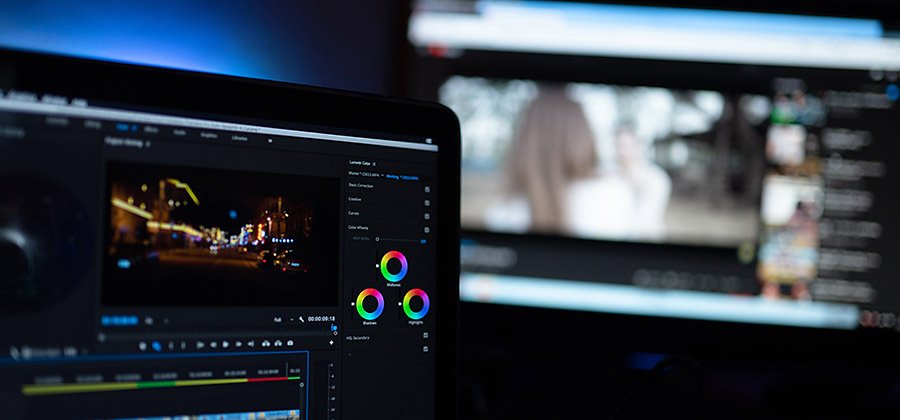Explore video bitrate.
Learn how the number of bits per second in a movie or video clip informs how professionals use, store, and transfer video files.

What is video bitrate?
Every second of video is packed with digital information. It could be a lot of information, like the high image quality of 4K video on physical media. Or less information, such as live streaming social media video from a phone with lower video and audio quality. Those two types of videos have a very different amount of data. The amount of information per second in video is known as bitrate.
“Bitrate refers to depth of information, whether in video or audio,” says director and filmmaker Mike Leonard. “It’s often measured as the amount of information per second.” Bitrate is distinct from other measurements of video quality such as frame rate, resolution, or video format. Those factors represent specific things about the nature of the footage, such as frames per second or how large the image is. Bitrate is more fundamental.

Bitrate is a slightly misleading term. Most bitrates are measured in bytes and megabytes. A megabyte is equal to a million bytes and a byte is 8 bits. So, despite being called “bitrate,” bits are not measured directly.
Bitrate encoding can vary a good deal given types of footage. On the low end, 720p is the type of video common in older HD televisions. 720p has a bitrate of about 6.5Mbps at a standard frame rate (24–30 frames per second) or 9.5Mbps on a high frame rate (48–60fps).
High-resolution 4K video encodes at 2160p and has a bitrate between 44 and 56Mbps on a low frame rate and 65 to 85Mbps with a high frame rate. That higher quality footage will look great, but the level of quality and usability are often at odds with each other.
Bitrate, storage, and usability.
Deciding on bitrate is a tradeoff between quality and functionality. Higher bitrates mean more information, but they also mean you need more storage for that information-heavy footage. Due to its size, that video file may be harder to work with as well. “The higher the bitrate, the higher the quality of video, but also the higher the file size,” says director and cinematographer Hiroshi Hara. Filming in higher resolution and at a high FPS will give you great footage, but you’ll have to account for all that image quality; sometimes time or budget constraints don’t allow for a high bitrate.


“If you’re out filming B-roll and you know you’re going to be out there for five hours and you don’t want to come back with massive files, you might decide to shoot at a lower bitrate,” says Leonard. Professionals need to think about time for processing, uploading, or downloading deliverables. They often need to balance project management considerations with video quality considerations.
In general, final footage for video content will have a lower bitrate than files filmmakers work with. “With streaming, there’s a restriction on bitrate,” says Hara. “If there’s too high of a bitrate you get a frozen or choppy image.”
Bitrate and visual effects.
Most viewers won’t be able to tell the difference between different bitrates. Bitrate matters most during production, especially when it comes to creating visual effects. “If we’re doing any sort of visual effects, we ideally aim to film in a higher bitrate, such as 10- or 12-bit, and at a larger picture resolution, like 4K or higher,” says Leonard.
The human eye might not be able to tell high bitrates apart, but the hardware and software used to make CGI certainly can. “If you were to show me an 8-bit and a 12-bit image I may not be able to look at it and tell the difference,” says Leonard. “But when I go in to do something like color or grading or keying and compositing, all that extra information is crucial for me to manipulate it and end up with a clean image.”

Video bitrate matters very much when visual effects artists work with a green screen, as well. Effects artists need to pull what’s known as a clean key from the green. That is, they need to be able to eliminate that specific green color effectively in order to replace it with visual effects. A higher bitrate means better video data, which allows for visual effects artists to more precisely eliminate that color green, and that color green only. When they do, they can replace it with visual effects that look much more convincing because they’re built on a good foundation of digital visual information.
Find the right bitrate.
There is no ideal bitrate, but it’s wise to use the highest bitrate your technology, budget, and capabilities will allow. “The rule of thumb that I think every DP (director of photography) or cinematographer will tell you is that you can always downgrade footage, but you can never upgrade footage once it’s shot,” says Leonard.
“Whenever you’re shooting something, you want to think of it as your foundation,” says Hara. “If you start with a lower-quality image, you’ll never be able to go higher than that. You always want the highest quality to start with.”
Your initial bitrate will inform the quality of all subsequent footage that comes from that video data. Aim for the highest practical bitrate. Think about what you need to create your project and how you’ll manipulate footage in post-production, and shoot accordingly.
Contributors
Do more with Adobe Premiere Pro.
Make visually stunning videos virtually anywhere — for film, TV, and web.
You might also be interested in…
Explore how audio bitrate relates to audio quality and user experience.
How to start a YouTube channel.
Stand out from the crowd and find success for your videos with these tips.
Enhance videos with Adobe Premiere Rush video editing software.
Improve video quality with color correction and audio adjustments using these user-friendly tools.
Reduce the size of a video file with Adobe Media Encoder.
Find out how to reduce the size of video files without reducing quality.
Get Adobe Premiere Pro
Create flawless productions with the industry-leading video editing software.
7 days free, then NIS 81.00/mo.



